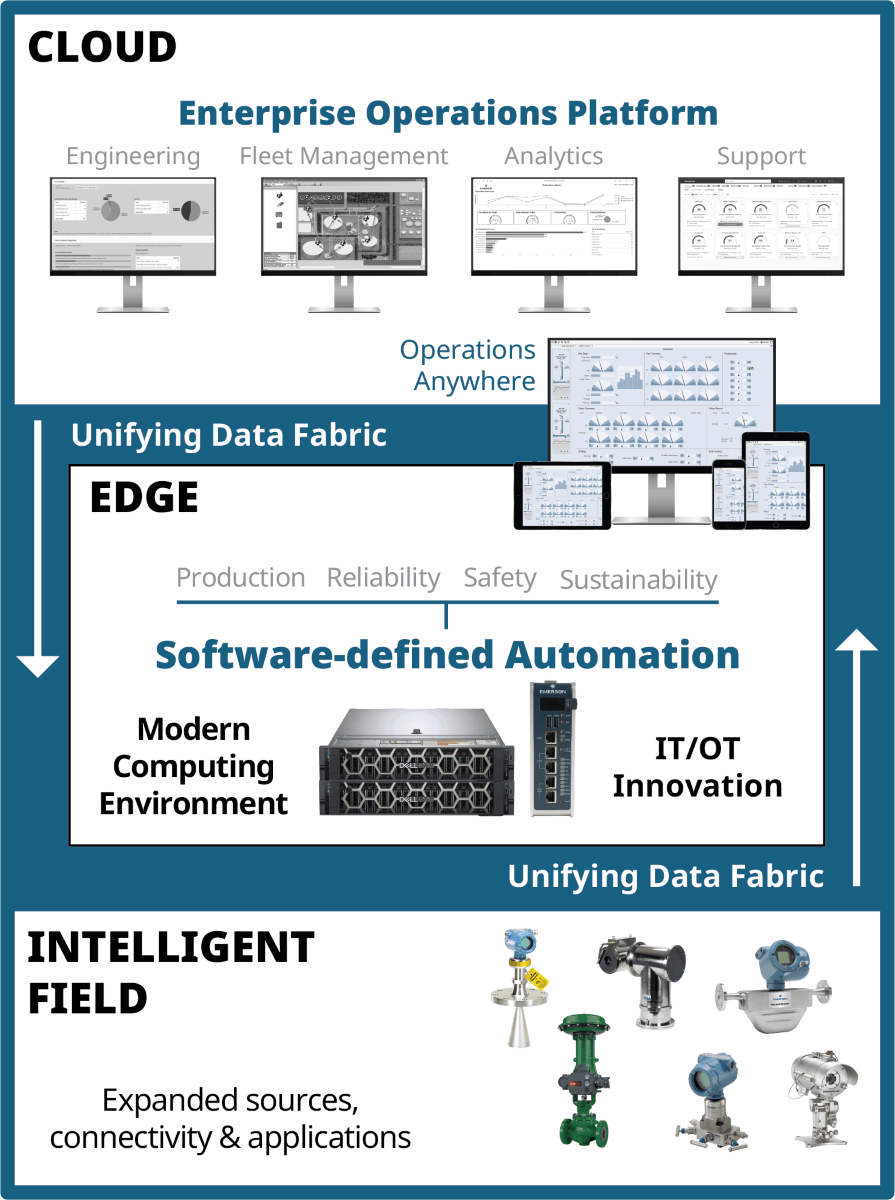Emerson's 'Boundless Automation' two years on
As the operational technology (OT) world continues its co-option of IT best practices, the architecture of process automation systems is starting to look less like the multi-layer Purdue model of yesteryear and more closely resembles that of the rest of the digital world: purpose-built smart devices connected to virtualized networks of local computing power, complemented by essentially unlimited cloud-based support. Emerson announced its own “Boundless Automation” vision of industrial automation—field, edge and cloud—at its Emerson Exchange user group event two years ago, and to check in on progress to date Control sat down with Emerson CTO Peter Zornio for a discussion that also ranged from generative AI to next year’s Emerson Exchange in San Antonio.
Get your subscription to Control's tri-weekly newsletter.
Q: Hard to believe, but it's already been two years since you and the rest of the Emerson team unveiled the vision of Boundless Automation at Emerson Exchange 2022 in Grapevine, Texas. To start things off, can you summarize the essential concepts of Boundless Automation and its implications for the industrial enterprise?
A: Boundless Automation is fundamentally Emerson's vision of how we see the next generation of automation technology. It's also our vision for overcoming the issues introduced by how industy has implemented automation solutions these past 25 years. In that paradigm, there's typically a big data source on the production side, most often the automation system, but then there are software applications for reliability, for quality, and now for sustainability being put into place. What typically happens is that each one of those functional departments ends up creating its own silo of data that is tied to the databases and the architecture structures in their own area.
What we believe needs to happen is implementation of a common data fabric that allows you to get at all that data—not just from the automation world, but from those other silos—in a manner that is pre-integrated with a common context. So, the majority of your data is there in one fabric, easily accessible by whatever kind of application needs it. This allows you to simultaneously optimize operations across various domains instead of being focused on just one of them. And that's increasingly important to customers as they fight to operate efficiently and cost competitively while increasing production, even as they add sustainability and other metrics to their goals.
Q: The year 2022 also marked Emerson taking a big equity stake in AspenTech, the acquisition of Inmation and an announcement by your CEO Lal Karsanbhai of Emerson’s intent to divest all those commercial and residential units and focus solely on industrial automation. What milestones have been achieved since?
A: Just a year ago, we released what we call the DeltaV Edge, which is a new product in the DeltaV portfolio. It's a node that sits on the DeltaV system and allows DeltaV data to pass through a one-way communications protocol—or even a physical data diode, if you like—to populate another set of processors running edge-based technology. It’s a node that uses what's called HCI, or hyperconverged infrastructure, which is a next-generation version of virtualization. What this node lets us do is create an entire digital twin of the DeltaV system, not just the process data, but alarm data, event data and configurations—essentially the complete context of the DeltaV data on the open edge side of that node.
Once you’re there you have access to all the more modern edge analysis tools. We added new capabilities for exporting the data via standards like JSON and MQTT, in addition to the OPC standards that we often use in the automation world. Another part of the Boundless Automation vision is allowing control to actually run on edge platforms, instead of only on purpose-built hardware. And we’ll have our first releases of that by the end of the next calendar year.
Q: It’s certainly no secret that the industries Emerson serves are facing a bit of an expertise crisis, with the waves of experienced operators and engineers retiring. What role does artificial intelligence, especially in the form of generative AI, promise to play in complementing the more traditional, analytics-based advisory tools like Plantweb Insight?
A: First, I’d remind your readers that industrial automation was AI long before AI was cool. Within AspenTech especially, the vast majority of their portfolio is around optimization, advanced control, planning and scheduling. That's all built on data models, but also first-principles models used in the design and simulation of process plants. What’s different from the AI we were using 25 years ago is that instead of using a narrowly defined algorithm trained on a specifically relevant set of data, generative AI uses a general-purpose model trained on broad data sets to answer a whole variety of questions.
In terms of the products Emerson develops and the value we can deliver to our customers, I think in terms of three buckets. The first is in the area of customer support: anyone who supplies an industrial or consumer product is working on developing an interactive copilot to guide its users. The second area is in the configuration of products. Industrial products, especially software and systems, require considerable site or application-specific configuration. We actually have a product today that can take configurations of older, competitive control systems and using AI quickly translate them into modern configurations for DeltaV. But I think the AI application that stirs everyone's imagination is the idea of an actual operations copilot that you can talk to—an interactive operator or operations advisor that you can ask for input on anything.
Q: I’m looking forward to connecting in person again next spring when the Exchange community will be gathering in San Antonio from May 19 to 22. Other than moving from what has usually been a fall cadence to the spring, any particular innovations and new things we should look out for?
A: Exchange attendees get to see in action all the things we just talked about—and more. But most of our users who participate say the biggest takeaway is the interaction with the other users they meet there, many of whom are facing the same challenges they are.



